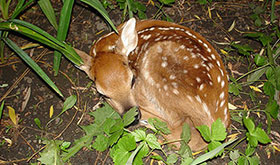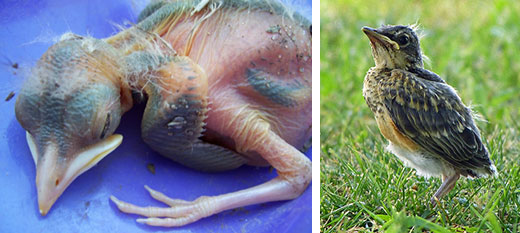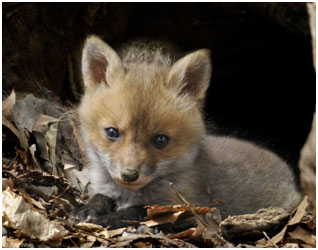Each year the Maryland Department of Natural Resources (DNR) receives numerous calls from citizens who, with the best of intentions, have “rescued” a young wild animal and are seeking tips on how to properly care for it. However, many times these citizens are endangering the lives of young wildlife by interfering with their natural adaptation and learning of basic survival skills.
Spring is a time when many native species are busy raising their young, and it can be very enjoyable to watch – but do so from a distance! Young animals are very cute and it’s often hard to resist the urge to help them, but remember, by interfering with them, more harm than good is done. Their chances of survival are much better if left in their natural surroundings to be raised by their parents.
Unless the animal appears injured or in distress, there is no need to rescue them.
Signs that a wild animal needs help:
- Evidence of bleeding
- An apparent or obvious broken limb
- A featherless or nearly featherless bird on the ground
- A dead parent nearby
- Audible distress calls (fawn crying, etc) given over a prolonged period of time.

Fawn by John Delano of Hammond, Wikimedia Commons
Species-specific signs
Baby Birds
Birds will not abandon their young if a person touches them. If the original nest was destroyed or is too high to reach, then you can affix a basket to the nearest limb closest to the nest. Do NOT put anything in the nest like cotton balls or other foreign materials as they can retain water and can cause the bird to become cold and die. If the original nest was destroyed or is too high to reach, then you can hang a small, shallow basket close to where you found the nest. Watch to make sure the adults return to the new or old nest within an hour. If they do not return, then
contact a wildlife rehabilitator.
Baby birds that are fully feathered and have short tail feathers are likely fledglings. Often, fledglings are seen hopping around on the ground and crying to their parents for food. Birds take time to learn how to fly, and fledging is part of the process! This stage takes several days, so it is best to keep pets away at this time.
When to step in: If a baby bird is injured, if you cannot reach the nest and/or the parents are not returning to the nest, or the parent is dead nearby then
contact a wildlife rehabilitator.

Young robins, the robin on the left is too young to survive on its own while the one on the right is a fledgling (Wikimedia Commons)
Baby Deer (Fawns)
It is completely natural for a fawn to be left on its own for 6 hours or more. After the female deer (doe) gives birth and nurses the fawn, she will lead it into secluded habitat within her home range. Twin fawns can be separated by up to 200 feet. The doe then leaves for extended periods of time because her scent can attract predators. Fawns have little to no scent of their own. The doe returns periodically to nurse her fawns and to relocate them to new secluded habitat. This pattern will continue for up to 3 weeks.
Does are wary of human smells, so it is important not to touch fawns. If you have already handled the fawn, then take a towel, rub it in the grass, and then wipe down the fawn to remove the human scent. Return the fawn to the place where you found it.
When to step in: Only if a fawn is wandering and crying incessantly or laying on its side, then it is likely to need help. Please
call a wildlife rehabilitator. that is authorized to possess fawns.
Baby Foxes
Baby foxes (kits) often are unsupervised for hours while their parents forage for food. If the kits appear energetic and healthy, then they should be left alone.
When to step in: If the kits appear sickly or weak and/or the parents are known to be dead, then
contact a wildlife rehabilitator.

Fox kit by John White
Baby Rabbits
Young rabbits, like fawns, have little smell and are often left for hours on their own to prevent attracting predators. Baby rabbits found in a nest should be left alone. Also, it is best to keep pets away from nests to prevent conflicts.
When to step in: If you suspect the nest has been abandoned/the young have been orphaned and/or are injured then contact a wildlife rehabilitator. Females will only visit nests 2-3 times per day, so you can mark the nest with a grassy X to see if she visits. She will move the X but keep the nest covered. If she does not visit after a day,
then it is time to call someone.

Rabbit nest in mulch pile by RK Lawson, Wikimedia Commons
Baby Squirrels
Young squirrels often fall from nests. If a squirrel nest falls from a tree or a younger squirrel falls out of a nest, then place them in a TALL box (safe from cats) with a heating source (hot water bottle or a water bottle with hot water) and a blanket. Don’t cover the squirrels as it will be harder for the female to find the young. Leave the box at the base of the tree where they fell from.
When to step in: If the female doesn’t return to care for the young afterafter 2-3 hours, if the young didn’t fall from the tree that day, and/or if the young are injured then
call a wildlife rehabilitator.
Things to Remember
- Never handle an adult animal without first consulting a wildlife professional and without surveying the situation.
- Always wear thick gloves and other protective materials when handling wildlife.
- Place the animal in a safe container. Many songbirds can be placed in a paper bag while larger animals may need a cardboard box lined with something soft like a towel.
- Keep the container in a warm, quiet place away from pets and children until transport.
- Handle the animal as little as possible to reduce stress and transport as soon as possible.
- Do not feed the animal without consulting a professional first.
- During transport, try to keep as quiet as possible to minimize stress.
For More Information, please contact:
Wildlife & Heritage Service
580 Taylor Ave. , E-1
Annapolis, MD 21401
410-260-8540
Toll-free in Maryland: 1-877-620-8DNR, follow the prompts to reach Wildlife and Heritage Service
TTY Users, please use Maryland Relay
fax 410-260-8596
E-Mail:
[email protected]